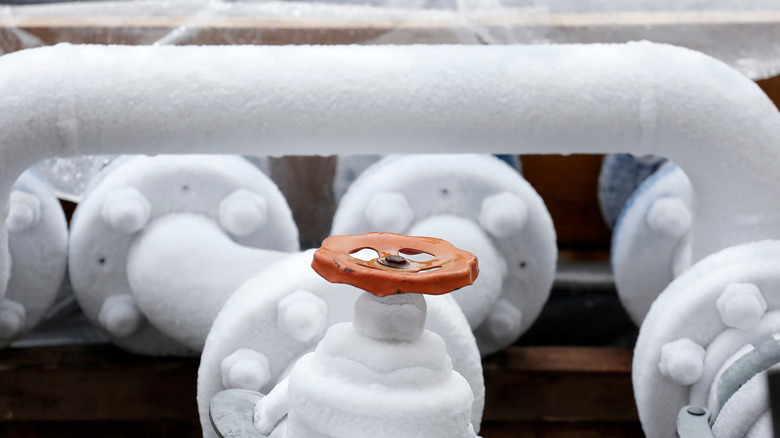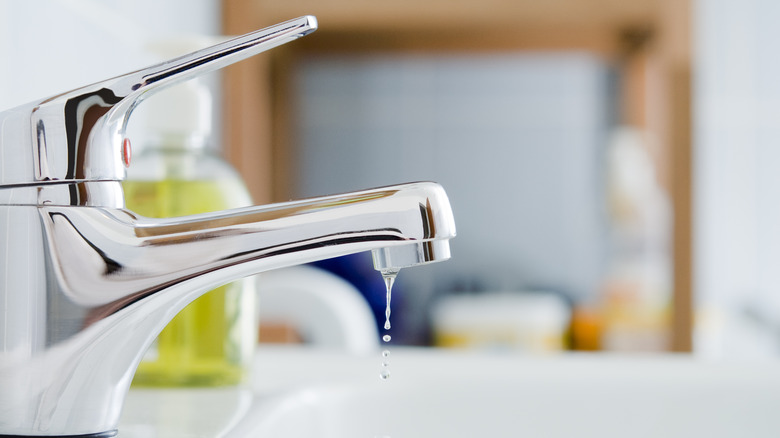Should You Try TikTok's Hair Dryer Hack For Defrosting Frozen Pipes?
When the depths of winter are upon us, it can be tempting to roll yourself into a fleeced cocoon on the couch with a cup of hot tea and your favorite feel-good movie. The wellbeing of the various pipes traversing your home may not be at the forefront of your mind ... but it should be. Frozen pipes can be dangerous – if they burst, they can cause extensive water damage throughout your home. Should the pipes burst, the overflow of water can also jeopardize the structural integrity of your home, leading to costly repairs and necessitating a temporary stay elsewhere while these issues are remedied. Nevertheless, one relatively safe way to defrost your pipes and avoid these outcomes is to use a hair dryer.
Using a hair dryer can help thaw frozen pipes. To do so, first turn on the faucet closest to these pipes to release pressure and encourage the water to run toward the opening. Then plug in the hair dryer and turn it to the heat setting. From a distance of 6 inches, point the hair dryer at the pipes starting at the end closest to the faucet and work your way down the pipes. As you move, oscillate the hair dryer back and forth to dissipate the heat across the pipe. This method should help melt the frozen water in the pipes but will require some patience.
Cautions for defrosting frozen pipes with a hair dryer
With any Internet hack, caution and safety should always be considered. Using a hair dryer to defrost frozen pipes may seem like a quick fix, but it comes with significant potential dangers. For one, the combination of water and electricity poses a serious hazard. Water conducts electricity, and using a hair dryer in proximity to wet pipes increases the risk of electrical shock. To avoid this danger, ensure that the area is completely dry before attempting any electrical intervention and hold the hair dryer away from any dripping water.
Secondly, overheating is a concern. Hair dryers are designed for personal use and may not have the built-in safety features necessary for prolonged operation. Continuous use on high heat settings can lead to the hair dryer overheating, damaging the appliance or, even worse, sparking a fire. It's important to monitor the hair dryer closely and avoid leaving it unattended while in use. If the hair dryer overheats, unplug it and allow it to cool before resuming this method.
Additionally, there's a risk of damaging the pipes. Excessive heat concentrated on one spot may cause a frozen pipe to expand too quickly, leading to cracks or bursts. This can result in water leakage, further exacerbating the existing issue. It's essential to maintain a safe distance, move the hair dryer continuously, and distribute the heat evenly to prevent localized pressure buildup.
How to prevent your pipes from freezing in the first place
So, maybe the hair dryer trick worked for you this time. If so, hopefully this experience will deter you from allowing your pipes to freeze again. Fortunately, there are plenty of steps you can take to avoid any need to defrost your pipes during the next cold snap. First and foremost, insulation is key. Ensure that pipes in vulnerable areas like crawl spaces or attics are properly insulated. This can be done with foam pipe insulation sleeves made from rubber or fiberglass. Adequate insulation acts as a barrier that reduces the risk of pipes reaching freezing temperatures.
Another preventive measure is letting faucets drip during extremely cold nights. Allowing a small, steady stream of water to flow helps prevent the water in the pipes from standing still and freezing, releasing dangerous pressure from the pipes as well. Moving water is less likely to freeze, so even a slow drip can make a significant difference, though a heavier drip may be necessary for very low temperatures.
Keeping the thermostat at a consistent temperature, even when you're away, can also prevent pipes from freezing. Sudden drops in temperature can lead to frozen pipes, so maintaining a stable indoor temperature is crucial. If you're planning to be away, consider setting the thermostat to a temperature above 50 degrees Fahrenheit to ensure the pipes stay warm. The last thing you want is to return from a trip to a flooded home.

